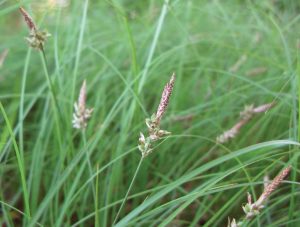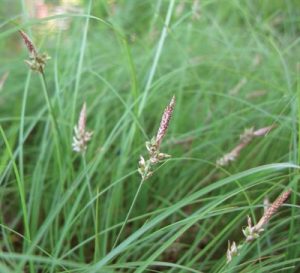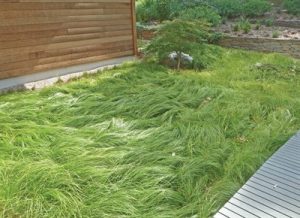American Nurseryman Magazine Staff — June 1, 2014


Click image to enlarge.
“I have a shady spot where I can’t get grass to grow.”
I hear it a lot. In fact, I heard it this past weekend from friends. They have a gently sloping, shady lot, and the area between planting beds is a patchwork of bare earth and shade-loving weeds—not the look they’re going for. They’ve reseeded turfgrass more than once, but it hasn’t been successful.
Traditional turfgrass struggles in shady conditions, especially in competition with large trees. That’s when one of my favorite plants comes into play: Pennsylvania sedge. For a shady site that gets minimal foot traffic, this increasingly popular sedge is a great choice.
Carex pensylvanica spreads slowly by rhizomes to form a lush, green carpet. The texture contrasts beautifully with large-leaved, shade perennials. Other sedges also have fine foliage, but Pennsylvania sedge somehow manages to look a little different. It has an appealing softness and uniformity. There’s a stand of this low-growing sedge outside my office window at Hoffman Nursery. Just a glance at its cool greenness and fine foliage brings my mental temperature down a few notches – perfect during the spring rush.
Native to eastern North America, it grows under hardwood forest canopies, forest edges, savannas, mountain balds, and in rocky or sandy openings. It often makes its home near oaks, earning it an alternative common name of oak sedge. Seeing Pennsylvania sedge blanket a forest floor is one of the highlights of a walk in the Blue Ridge Mountains of North Carolina.
As a cool-season plant, Pennsylvania sedge completes its life cycle before the heat and drought of summer arrive. It begins growing in early spring and by late spring produces intricate spikelets on delicate inflorescences. They rise just above the foliage and are a charming addition that adds texture and interest. Carex pensylvanica produces seed, but germination is rare in natural populations.
As summer heats up, Pennsylvania sedge slows down. Here in central North Carolina, our heat load can make it look a little ragged by August. However, it will perk up with a flush of new growth as temperatures cool in the fall. If necessary, it can be cut back in late winter or very early spring before new growth appears.
The delicate look of this sedge belies its workhorse nature. As a lawn alternative for shade, it doesn’t need regular mowing, but it can be cut back two to three times a year if desired. Carex pensylvanica also fits perfectly as a groundcover or as a base layer for taller perennials. It performs beautifully in our dry shade garden at the nursery. In general, it does best in dry, well-drained soils, but it will handle a range of soil conditions from clay to sandy loams. In cooler climates, it will tolerate more sun than it does in the heat and humidity of the Southeast.

Click image to enlarge.
Photos courtesy of Shannon Currey, Hoffman Nursery Inc.
Given the adaptability of Pennsylvania sedge, it offers a great solution to my friends’ shady spot. The area they’re targeting will get minimal foot traffic and is on a well-drained, gentle slope. They can plant this beautiful, native sedge and stop struggling with turfgrass. It will take a few years to establish a lush stand like the one I enjoy outside my window, but it will be worth it. No more mowing and a cool green carpet – that’s a great shade solution.
Shannon Currey
Director of Sales & Marketing, Hoffman Nursery Inc.
[email protected]
Name: Carex pensylvanica
Common name(s): Pennsylvania sedge, oak sedge
Hardiness: Zones 4 to 8
Mature height: 8 inches
Mature spread: Gentle spreader
Classification: Ornamental sedge, groundcover
Landscape use: Low, spreading groundcover; turfgrass alternative for shade; excellent base for woodland plantings; contrasts well with broad-leaved shade plants such as Aesculus, Heuchera, Polygonatum, Hydrangea, Helleborus and Hosta.
Ornamental characteristics: Fine-textured foliage that forms a soft, green carpet; intricate spring blooms that add interest in spring